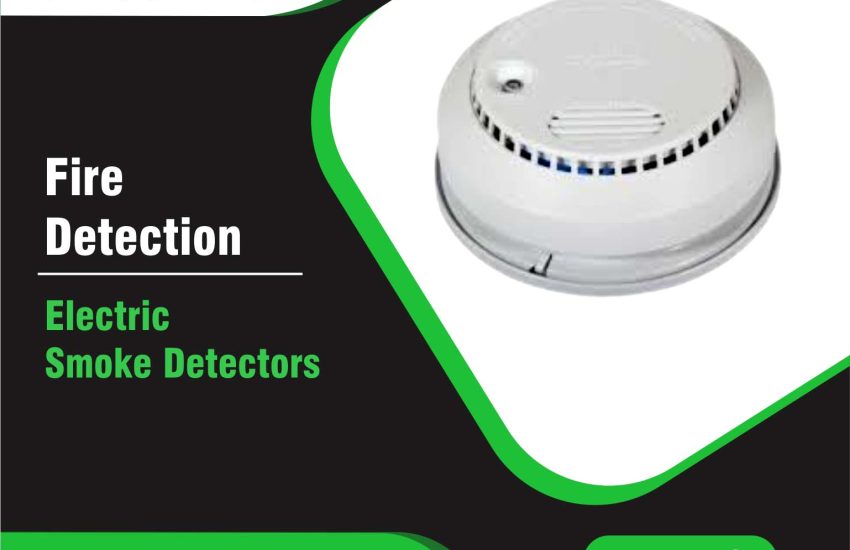Electric Smoke Detectors are crucial devices designed to protect lives and property by detecting smoke and triggering alarms to warn occupants of potential fire hazards. These devices are used in residential, commercial, and industrial settings, offering early alerts that can significantly reduce the risk of fire-related injuries and fatalities. This article discusses the specifications, types, and key features to consider when selecting the right electric smoke detector for your needs.
What Are Electric Smoke Detectors?
Electric smoke detectors, also known as electrical smoke alarms, are safety devices that use sensors to detect smoke in the air. Once smoke is detected, the detector triggers an alarm to alert building occupants. These detectors are typically powered by the building’s electrical system and may include a battery backup in case of power failure. Electric smoke detectors are widely used in homes, offices, commercial buildings, and industrial environments for fire prevention and safety.
Key Specifications of Electric Smoke Detectors
Understanding the specifications of electric smoke detectors is crucial to ensure you select the right device. Here are the key factors to consider:
1. Power Supply and Voltage
Electric smoke detectors are powered by a low-voltage electrical system, usually 120V AC or 230V AC, depending on your region. Many models feature a battery backup, ensuring that the alarm continues to work during power outages. Additionally, some models allow the connection of multiple detectors to a single power source, which helps create a network of alarms throughout a building.
2. Type of Sensor
There are two main types of sensors used in electric smoke detectors:
- Ionization Smoke Detectors: These use a small amount of radioactive material to ionize the air in a sensing chamber. Smoke particles disrupt the ionization, triggering the alarm. Ionization detectors are more sensitive to fast-flaming fires but less sensitive to smoldering fires.
- Photoelectric Smoke Detectors: These use a light sensor to detect smoke. The smoke scatters the light beam, activating the alarm. Photoelectric detectors are more effective at detecting slow-smoldering fires, which produce more smoke but less visible flame.
Many modern detectors combine both sensor types for comprehensive protection.
3. Response Time
Response time refers to how quickly a smoke detector can detect smoke and activate the alarm. A smoke detector should ideally detect smoke as soon as it enters the sensing chamber. Fast response times provide more time for occupants to react during a fire emergency. The quicker the detector responds, the better the protection it offers.
4. Connectivity and Smart Features
Today’s electric smoke detectors come with advanced features, offering greater convenience and safety:
- Wi-Fi Connectivity: Some models send notifications to your smartphone when smoke is detected or when the battery is low.
- Home Automation Integration: Many smart detectors integrate with home automation systems like Alexa or Google Home, enabling voice alerts and control.
- Multi-Unit Communication: Some detectors can communicate with others. When one alarm goes off, others in the network also trigger, ensuring alerts are heard throughout the building.
These features enhance convenience, particularly in larger buildings or homes with multiple floors.
5. Battery Life and Maintenance
While most electric smoke detectors are powered by the building’s electrical system, many also feature a backup battery. Battery life is a key specification, with most detectors using batteries that last between 1 and 10 years. It’s essential to replace the batteries regularly to ensure the alarm functions correctly. Many models include a low-battery indicator, which alerts users when it’s time to replace the battery.
Regular maintenance, such as testing the detector monthly and replacing batteries as needed, is crucial for proper functionality.
6. Sound Output and Alarm Volume
The sound output or alarm volume of a smoke detector is important to ensure occupants can hear the alarm, even in noisy environments. A typical recommendation is for an alarm volume of at least 85 dB at 10 feet. For commercial or industrial applications, louder alarms may be necessary to ensure the alarm is heard throughout larger spaces.
7. Certifications and Standards Compliance
Make sure the smoke detector you choose complies with local safety standards and certifications. Some key certifications to look for include:
- UL (Underwriters Laboratories) Certification: This certification ensures the device meets national safety standards.
- CE Marking: Indicates compliance with European Union regulations.
- NFPA (National Fire Protection Association) Standards: In the U.S., smoke detectors should comply with NFPA 72.
Compliance with these standards ensures reliable performance and safety.
Types of Electric Smoke Detectors
Electric smoke detectors come in various types to suit different needs:
1. Hardwired Smoke Detectors
Hardwired smoke detectors connect directly to the building’s electrical system. Install them in hallways, kitchens, and bedrooms to provide continuous power. Many residential and commercial buildings use hardwired detectors for their reliability.
2. Battery-Powered Smoke Detectors
Battery-powered detectors are ideal for areas where wiring is difficult or impractical. These detectors are easy to install and move but require regular battery changes to maintain optimal performance.
3. Smart Smoke Detectors
Smart smoke detectors connect to Wi-Fi or Bluetooth and can send alerts to your smartphone. They also integrate with home automation systems, offering added convenience and remote monitoring capabilities.
4. Combination Smoke and Carbon Monoxide Detectors
Some electric smoke detectors also detect carbon monoxide (CO). These dual detectors are ideal for homes with gas appliances or heating systems, providing protection from both smoke and CO poisoning.
Conclusion
Electric smoke detectors are an essential part of any fire safety system, offering early warnings that can save lives and minimize property damage. By understanding the key specifications and types of smoke detectors, you can make an informed decision on which model best suits your needs. Whether you need a basic ionization detector, a dual-sensor model, or a smart smoke detector, proper installation and maintenance will ensure effective fire protection.


